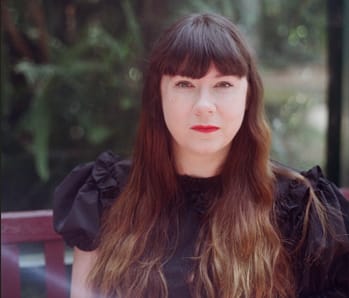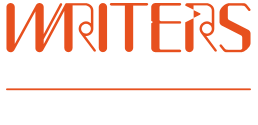
Gabriella Munoz, our Acting Membership Officer, sat down with our very own Program and Partnerships Manager, Anna Kate Blair, to talk about her debut novel, The Modern, and all things writing.
Anna is a writer, arts worker and cultural historian from Aotearoa. Before starting at Writers Victoria in 2022, she worked at arts and educational organisations including the Museum of Modern Art in New York, the University of Melbourne and the University of Cambridge, where she also completed a PhD in History of Art and Architecture. Her essays, short stories and poems have been published in journals including Cordite Poetry Review, Meanjin, The Big Issue’s Fiction Edition, Landfall, Headland, Reckoning and Archer, and she’s won prizes including the Warren Trust Award for Architectural Writing, the Wyndham Short Story Prize and the AAWP Slow Canoe Creative Nonfiction Prize. In 2019, Anna was a recipient of Writers Victoria’s Grace Marion Wilson Fellowship for Emerging Writers, over the course of which she worked on an early draft of The Modern.
Your debut novel The Modern is now out! Tell us about your book.
My novel follows Sophia, a Curatorial Fellow at the Museum of Modern Art (MoMA) in New York, over the course of the summer of 2016. At the beginning of the novel, she accidentally becomes engaged to her boyfriend when they’re a bit drunk and not really thinking about it. He leaves, then, the next day, to hike the Appalachian Trail and she spends the summer overthinking it. She also becomes infatuated with a young artist, Cara, who is working as a bridal store assistant, and that gives her even more to overthink.
I tend to describe it differently based on audience, though, so that’s the plot-based summary that I’ve fallen into the habit of offering. For an audience of writers, I’d say that The Modern is about ways in which people process their experiences through art, about the relationship between narrative and life itself, about poetry and painting, bisexuality, New York, the concept of wilderness and lots of other things.
When was the most challenging bit about writing The Modern?
I don’t feel like the writing itself was challenging so much as cultivating the recklessness and confidence that’s required to write a novel. Objectively, it was an absurd thing for me to do. I’d had very little training in creative writing and I was, when I started, mostly an arts and travel writer, with perhaps one short story published. In writing The Modern, I was also teaching myself to write.
It’s worked out well, as it’s now been published and I have a great job at Writers Victoria, but I did feel, for a while, that writing a novel was not very good for my career, my relationships or my ability to remain in the countries where I wanted to live, so I think the hardest part of writing The Modern was maintaining the belief that it was a good idea, even with very few external signs of this. It felt very precarious and I knew I was sacrificing things for it. I feel like the psychological aspects of writing a novel were a lot harder than the actual writing.
I read recently that it takes a village to write a book. Do you agree? Did you have a village when writing The Modern?
I’m not sure. I’m never really a person who feels like they have a village (alas, I’m a child of post-modernity, suffering the curse of the atomised individual), and the support that I had was scattered around the world, so perhaps it was more like satellites offering pinpricks of light and beaming electronic signals. My friends helped a lot, though, in that they said nice things about my writing, which buoyed my self-esteem such that I could write the book. As I was writing The Modern, I published essays and other things in various publications, and a lot of writers I admired followed me on social media or told me they liked my essays which, again, made me think that what I was doing perhaps wasn’t the worst thing in the world.
I had an online writing group, with Alex O’Sullivan and Roz Bellamy, during the lockdowns, and we emailed each other about 2500 words and met on Zoom to discuss our manuscripts every week; we talked for hours each time and became very close. This need to finish or polish sections so I could send them to my friends helped more than anything else, I think, as did our long conversations. Roz’s book, Mood, is coming out in October, too, and Alex has published some wonderful essays over the last few years, so it’s lovely to still have that friendship and togetherness through the publication process.
Just like the protagonist in your book, you worked at MoMA. What’s your fondest memory of the museum? Do you have a favourite wing?
I’m very biased; my favourite parts of the museum are those dedicated to architecture and design, because I worked in Architecture and Design and know the collection well. I also think MoMA’s Architecture and Design Department is very socially and politically engaged, which I appreciate. But that’s obviously a very partial answer.
If I remove Architecture and Design from the equation, I’d say Prints and Drawings were doing interesting shows when I was there. Many of their shows were quite conceptual, and a lot of the artists they were exhibiting, like Marcel Broodthaers and Yoko Ono, were creating installations and performances rather than sticking to what we traditionally see as a print or a drawing. I also love photography and MoMA is great in this area, too.
In terms of my fondest memory, my favourite part of working at MoMA was just having an intimate, everyday relationship with the museum and its spaces as opposed to a tourist’s relationship where you just visit once or every couple of months. It was nice to feel like I lived there, to notice shifts in atmosphere across different moments in the day or the ways that different people experienced different pieces.
If The Modern were a painting, what painting would it be?
The book would probably say that a novel can’t be a painting because it’s not one fixed image: a novel fluctuates and changes, progresses, regresses. I think paintings can do this, too, but it’s not the same. There’s a chapter in The Modern that’s built around Nan Goldin’s Ballad of Sexual Dependency, which is a series of images, a slideshow, and I think the book is more like a slideshow than a painting.
One of the characters in The Modern is a literature academic while the protagonist is focused on painting. I did want, with that, to explore the tension between a painting as something that’s in the moment while a book (usually) does have a narrative and, through that, a different relationship to time and the idea of progress. Some paintings do have narratives, of course, but the modern paintings that the protagonist studies generally aren’t concerned with this.
In terms of the vibe of the book, though, perhaps The Modern would be one of Joan Mitchell’s paintings. But, I realise, after saying that, that there is an obvious answer to this question: it’s the painting the narrator is obsessed with, which is Grand Street Brides by Grace Hartigan. I like to think The Modern is ambivalent, ambiguous, playful-yet-serious and slightly haunted in the same way as this painting.
How does your knowledge of architecture influence the way in which you approach and structure your writing? When you write, do you plan your writing in such a way that it matches how you would build a building? How does having that knowledge of how buildings work influence how you build words in your book or in your short stories?
This is something I always talk about when I teach experimental architectural writing workshops. There are a lot of architectural writers who do structure their work in that kind of way, and I’m very interested in engineering as a source of inspiration. My work is influenced by art and architecture, but I’m not an architect or an engineer. There is a Frank o Hara poem, ‘To Larry Rivers,’ which I think about, often; it finishes with the phrase you do what I can only name. I couldn’t really structure a book after a building, as much as I love that idea, because I can’t engineer or build any kind of complex structure, but I’m interested in the questions that emerge through architectural history and art theory and how those questions might be explored through other creative forms.
An example I’ve given before, in answer to a similar question, is a short story, ‘Cultural Capital,’ that I wrote a few years ago about an artwork, Ben Vautier’s Total Art Matchbox, where the instruction of the artist is to burn all the art in the gallery. In non-fiction, I can’t explore this in the same way; I’m not going to go and burn all the art in a gallery because an artist tells me to do so. In fiction, though, you can have a character do that. You can have a character who believes so much in what an artist is doing that they’re willing to destroy art for the sake of art. So, I guess I kind of think of fiction particularly as a space where those kind of questions about art and architecture can be explored in a different way to non-fiction. I like to think of fiction as a form of institutional critique or, alternately, as a space in which to explore the emotion and experience that underpins our aesthetic attachments. I’ve focused more on visual art than architecture in writing fiction, over the past few years, but I’d like to bring architecture back into it, too.
Anna’s novel The Modern is out now with Scribner Australia.
